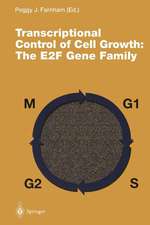TOR: Target of Rapamycin: Current Topics in Microbiology and Immunology, cartea 279
Editat de George Thomas, David M. Sabatini, Michael N. Hallen Limba Engleză Paperback – 21 oct 2012
TOR, the Target of Rapamycin was discovered a little over ten years ago in a genetic screen in S. cerevisiae in search of mutants resistant to the cytostatic effects of the antimycotic, rapamycin. Recent studies have placed TOR at the interface between nutrient sensing and the regulation of major anbolic and catabolic responses. The editors have gathered the leading figures in the field of TOR and its role in cellular homeostasis and human diseases.
| Toate formatele și edițiile | Preț | Express |
|---|---|---|
| Paperback (1) | 1414.29 lei 6-8 săpt. | |
| Springer Berlin, Heidelberg – 21 oct 2012 | 1414.29 lei 6-8 săpt. | |
| Hardback (1) | 1418.48 lei 6-8 săpt. | |
| Springer Berlin, Heidelberg – 25 aug 2003 | 1418.48 lei 6-8 săpt. |
Din seria Current Topics in Microbiology and Immunology
- 18%
 Preț: 962.03 lei
Preț: 962.03 lei - 5%
 Preț: 1123.13 lei
Preț: 1123.13 lei -
 Preț: 499.76 lei
Preț: 499.76 lei - 5%
 Preț: 967.79 lei
Preț: 967.79 lei - 18%
 Preț: 1118.62 lei
Preț: 1118.62 lei - 5%
 Preț: 717.00 lei
Preț: 717.00 lei - 5%
 Preț: 712.97 lei
Preț: 712.97 lei - 5%
 Preț: 709.51 lei
Preț: 709.51 lei - 5%
 Preț: 709.51 lei
Preț: 709.51 lei - 5%
 Preț: 721.19 lei
Preț: 721.19 lei - 5%
 Preț: 359.78 lei
Preț: 359.78 lei - 5%
 Preț: 711.88 lei
Preț: 711.88 lei - 5%
 Preț: 774.81 lei
Preț: 774.81 lei - 15%
 Preț: 640.06 lei
Preț: 640.06 lei - 5%
 Preț: 717.00 lei
Preț: 717.00 lei - 5%
 Preț: 360.34 lei
Preț: 360.34 lei - 5%
 Preț: 707.69 lei
Preț: 707.69 lei - 5%
 Preț: 717.56 lei
Preț: 717.56 lei - 5%
 Preț: 716.28 lei
Preț: 716.28 lei - 5%
 Preț: 717.20 lei
Preț: 717.20 lei - 5%
 Preț: 711.32 lei
Preț: 711.32 lei - 5%
 Preț: 711.88 lei
Preț: 711.88 lei - 5%
 Preț: 718.29 lei
Preț: 718.29 lei - 5%
 Preț: 709.51 lei
Preț: 709.51 lei - 5%
 Preț: 369.84 lei
Preț: 369.84 lei - 5%
 Preț: 712.25 lei
Preț: 712.25 lei - 5%
 Preț: 716.45 lei
Preț: 716.45 lei - 5%
 Preț: 706.60 lei
Preț: 706.60 lei - 5%
 Preț: 711.52 lei
Preț: 711.52 lei - 5%
 Preț: 713.54 lei
Preț: 713.54 lei - 5%
 Preț: 720.47 lei
Preț: 720.47 lei - 5%
 Preț: 725.42 lei
Preț: 725.42 lei - 5%
 Preț: 708.06 lei
Preț: 708.06 lei - 5%
 Preț: 713.70 lei
Preț: 713.70 lei - 5%
 Preț: 705.83 lei
Preț: 705.83 lei - 5%
 Preț: 710.96 lei
Preț: 710.96 lei - 5%
 Preț: 723.93 lei
Preț: 723.93 lei - 5%
 Preț: 707.69 lei
Preț: 707.69 lei - 5%
 Preț: 715.35 lei
Preț: 715.35 lei - 5%
 Preț: 709.87 lei
Preț: 709.87 lei - 5%
 Preț: 359.05 lei
Preț: 359.05 lei - 5%
 Preț: 374.20 lei
Preț: 374.20 lei - 15%
 Preț: 635.31 lei
Preț: 635.31 lei - 5%
 Preț: 707.86 lei
Preț: 707.86 lei - 5%
 Preț: 721.96 lei
Preț: 721.96 lei - 15%
 Preț: 632.88 lei
Preț: 632.88 lei - 15%
 Preț: 632.05 lei
Preț: 632.05 lei - 15%
 Preț: 642.83 lei
Preț: 642.83 lei - 5%
 Preț: 709.14 lei
Preț: 709.14 lei
Preț: 1414.29 lei
Preț vechi: 1488.72 lei
-5% Nou
Puncte Express: 2121
Preț estimativ în valută:
270.65€ • 280.85$ • 226.22£
270.65€ • 280.85$ • 226.22£
Carte tipărită la comandă
Livrare economică 15-29 martie
Preluare comenzi: 021 569.72.76
Specificații
ISBN-13: 9783642623608
ISBN-10: 3642623603
Pagini: 380
Ilustrații: X, 364 p.
Dimensiuni: 155 x 235 x 20 mm
Greutate: 0.53 kg
Ediția:Softcover reprint of the original 1st ed. 2004
Editura: Springer Berlin, Heidelberg
Colecția Springer
Seria Current Topics in Microbiology and Immunology
Locul publicării:Berlin, Heidelberg, Germany
ISBN-10: 3642623603
Pagini: 380
Ilustrații: X, 364 p.
Dimensiuni: 155 x 235 x 20 mm
Greutate: 0.53 kg
Ediția:Softcover reprint of the original 1st ed. 2004
Editura: Springer Berlin, Heidelberg
Colecția Springer
Seria Current Topics in Microbiology and Immunology
Locul publicării:Berlin, Heidelberg, Germany
Public țintă
ResearchCuprins
TOR: The First Ten Years.- The Role of Phosphatases in TOR Signaling in Yeast.- Yeast TOR Signaling: A Mechanism for Metabolic Regulation.- Nutrient Signaling Through TOR Kinases Controls Gene Expression and Cellular Differentiation in Fungi.- Autophagy in Yeast: A TOR-Mediated Response to Nutrient Starvation.- The Fission Yeast TOR Proteins and the Rapamycin Response: an Unexpected Tale.- Plant Growth and the TOR Pathway.- TOR Action in Mammalian Cells and in Caenorhabditis elegans.- Genetic Analysis of TOR Signaling in Drosophila.- Interplay Between Growth Factor and Nutrient Signaling: Lessons from Drosophila TOR.- mTOR Signaling to Translation.- Modulation of the Protein Kinase Activity of mTOR.- Role of mTOR Signaling in the Control of Translation Initiation and Elongation by Nutrients.- Novel Regulatory Mechanisms of mTOR Signaling.- Raptor and mTOR: Subunits of a Nutrient-Sensitive Complex.- Kinase Activities Associated with mTOR.- mTOR: A Mediator of Intracellular Homeostasis.- mTOR as a Positive Regulator of Tumor Cell Responses to Hypoxia.- Retroviral Oncogenes and TOR.- mTOR as a Target for Cancer Therapy.
Textul de pe ultima copertă
TOR, the Target of Rapamycin was discovered a little over ten years ago in a genetic screen in S. cerevisiae in search of mutants resistant to the cytostatic effects of the anti-mycotic, rapamycin. Since that time orthologues have been identified in all eukaryotes examined to date, including humans. Recent studies have placed TOR at the interface between nutrient sensing and the regulation of major anabolic and catabolic responses. The significance of understanding the molecular mechanisms which control TOR function has been underscored by Phase 1 clinical trials, showing that rapamycin is not only therapeutically important as an immunosuppressive but is also efficacious in the treatment of solid tumors. Indeed, currently, homologues of rapamycin are in broad-based trials to determine its use in the treatment of other pathological conditions, such as inflammation and restenosis. Given these observations a great deal of attention has been drawn to TOR and its role cellular homoeostasis and human disease. Here we have gathered the leading figures in the field to summarize their own contributions to uncovering TOR function and to speculate where they think the field will be moving in the next few years.



















